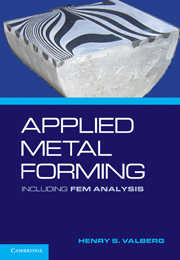Book contents
- Frontmatter
- Contents
- Preface
- APPLIED METAL FORMING
- 1 Characteristics of Metal Forming
- 2 Important Metal Forming Processes
- 3 FEA of Metal Forming
- 4 Theory
- 5 Reduction and Proportions of the Plastic Zone
- 6 Deformations from the Velocity Field
- 7 Technological Tests and Physical Simulation
- 8 Flow Stress Data
- 9 Formability and Workability
- 10 Friction and Friction Models
- 11 Thermal Effects
- 12 Experimental Metal Flow Analysis
- 13 Theoretical Methods of Analysis
- 14 Finite Element Analysis
- 15 FEA of Technological Tests
- 16 Forging
- 17 FEA of Forging
- 18 Extrusion
- 19 FEA of Extrusion
- 20 Rolling
- 21 FEA of Rolling
- 22 Drawing of Wire, Profiles, and Tubes
- 23 FEA of Wiredrawing
- 24 Sheet-Metal Forming
- Index
- References
18 - Extrusion
Published online by Cambridge University Press: 05 June 2012
- Frontmatter
- Contents
- Preface
- APPLIED METAL FORMING
- 1 Characteristics of Metal Forming
- 2 Important Metal Forming Processes
- 3 FEA of Metal Forming
- 4 Theory
- 5 Reduction and Proportions of the Plastic Zone
- 6 Deformations from the Velocity Field
- 7 Technological Tests and Physical Simulation
- 8 Flow Stress Data
- 9 Formability and Workability
- 10 Friction and Friction Models
- 11 Thermal Effects
- 12 Experimental Metal Flow Analysis
- 13 Theoretical Methods of Analysis
- 14 Finite Element Analysis
- 15 FEA of Technological Tests
- 16 Forging
- 17 FEA of Forging
- 18 Extrusion
- 19 FEA of Extrusion
- 20 Rolling
- 21 FEA of Rolling
- 22 Drawing of Wire, Profiles, and Tubes
- 23 FEA of Wiredrawing
- 24 Sheet-Metal Forming
- Index
- References
Summary
As previously described in Ch. 2, extrusion is done by placing a piece of metal of good formability, called a billet, in a hardened steel container. In direct extrusion, a ram is then pushed from the back end of the container, so the billet is forced against a die placed at the other end of the container. The die has a hole in its middle, and as the billet is pushed forward, the front part of it starts to flow into the hole, and then out into the space at the exit side of the hole. Here it appears as a continuous extrusion with cross section approximately that of the hole. The longitudinal shape obtained in this process is generally called an extruded profile, or an extrudate. This metal forming technique is hence used to manufacture products with constant cross-sectional shape along their length, either as massive or hollow profiles, or as rod, tube, wire, or strip.
Because the flow stress is reduced when metals are heated, and workability also most commonly increases, extrusion is usually conducted as hot forming. Extrusion can either be done as forward (direct) or backward (indirect) extrusion; see Ch. 2.2.5. In forward extrusion, the material is pushed through the container and the die by means of the ram, whereas in backward extrusion, the die is placed in front of the hollow ram, whereafter the die is pushed into the billet.
- Type
- Chapter
- Information
- Applied Metal FormingIncluding FEM Analysis, pp. 320 - 346Publisher: Cambridge University PressPrint publication year: 2010
References
- 1
- Cited by



